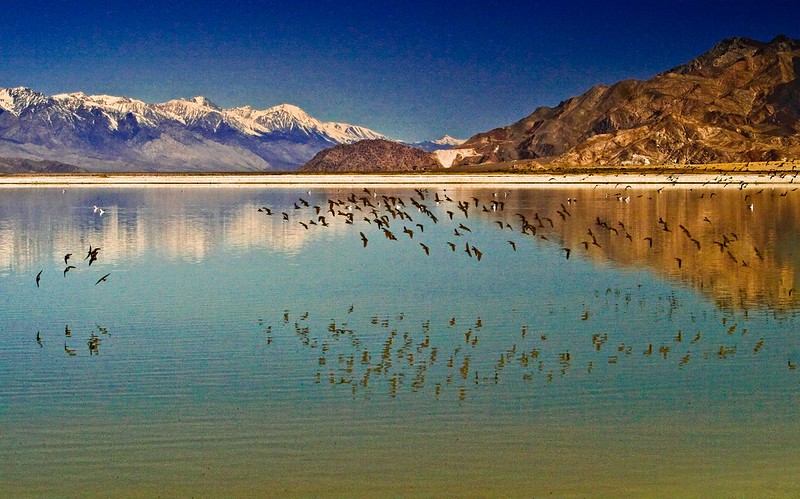What is the Owens Lake Project?

I made my first drive down Highway 395 in the Eastern Sierra Nevada in the summer of 2009 when returning home to Los Angeles from my first trip to Yosemite National Park. I instantly fell madly in love with the area and began making the drive up from Los Angeles with some frequency; each time, I was fascinated by the Owens Lake as I drove past the western shore. I began reading everything I could find about the lake, and began exploring the lakebed itself any time I traveled to the Eastern Sierra for photography. It would be less than a year after that first trip that this project got its start.
In the years since, I’ve covered the bird life on the lake and the slow, dogged fight by local conservation groups to get the Los Angeles Department of Water and Power (LADWP) to consider habitat protection in addition to its court-ordered responsibility to mitigate blowing toxic dust on the lakebed.
Some quick facts about the lake:
What was once a 110-square-mile lake estimated to be 1,000,000 years old began disappearing when the Los Angeles Aqueduct opened in 1913, diverting the entire lower Owens River away from the lake. A once-vibrant ecosystem that supported expansive bird and plant habitats began disappearing, replaced by a dry lakebed plagued by noxious and almost constant dust storms and turning communities around the lake into ghost towns. Forced under court order after decades of litigation to begin releasing water back into the lower Owens River, the LADWP finally diverted a small, highly controlled flow from the aqueduct and water began to flow towards the lake in late 2006.
LADWP’s only legal requirement was to mitigate the blowing dust and institute effective dust control programs, but it has had the added benefit of reviving in small part the ecosystem that once flourished as a breeding ground for millions of birds, and supported vast and beautiful alkali meadows around the lake. Since re-watering of the lower Owens River commenced, bird populations around the lake have increased exponentially and the native plant life has begun to revive as well. To ensure continued restoration of the Owens Lake that now includes habitat restoration as a goal, a network of groups in the Owens Valley including the Eastern Sierra Audubon Society, the Owens Valley Committee, the Bristlecone Pine Chapter of the California Native Plants Society and the Eastern Sierra Land Trust began lobbying and working with the LADWP to get the utility to consider some kind of habitat preservation at the lake.
It’s been over six years since the LADWP dedicated the Owens Trails and constructed a network of habitats to support bird life at the lake. It’s time to revisit the lake and see how those habitats are maturing and expand the scope of this documentary to include all the wildlife at home on the lake–and the diversity may surprise you!
Now that I’m actively back at work on the project, check back often for new blog updates, and follow along on social media by clicking any of the icons at the top of the page.
For questions or for more information about this project, contact me at robin@robinblackphotography.com. All photographs by Robin Black are © Copyright Robin Black. Any and all use in any form requires advance permission from the photographer, and unauthorized uses will be pursued. Please contact this site to request permission in the form of a license.
2 Comments
Pingback:
Pingback: